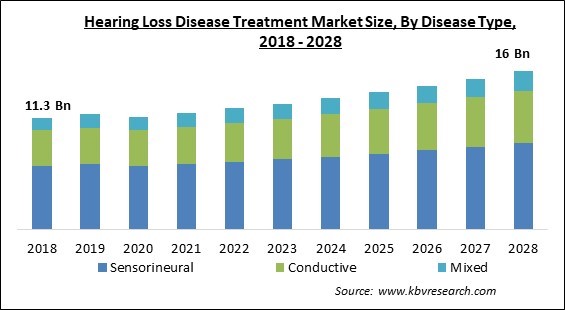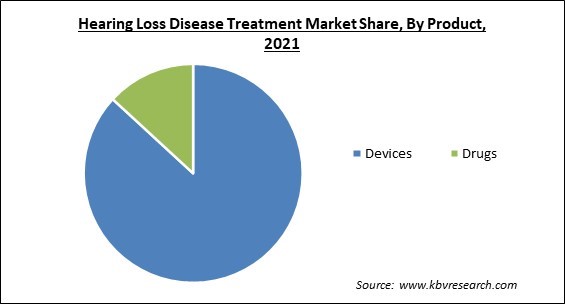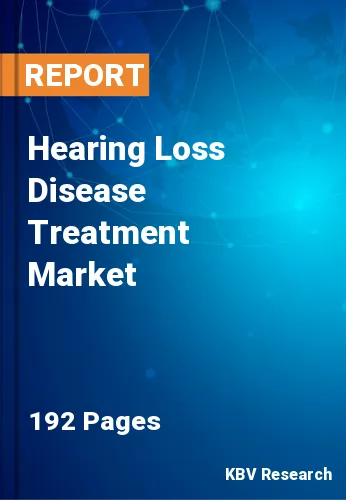The Global Hearing Loss Disease Treatment Market size is expected to reach $16 billion by 2028, rising at a market growth of 4.6% CAGR during the forecast period.
Hearing loss is a serious circumstance that has a complicated effect on the individual’s development & growth. It could lead to loneliness & isolation and can also considerably decreases the quality of life. Hearing loss may have a great influence on the daily life of the individual. From a young age, the person might encounter speech & language skills problems at school and a social environment.

The hearing loss problem is increasing gradually due to many causes. Aside from hereditary reasons, age is one of the critical factors for hearing loss. The commonly known hearing loss type is age-related hearing loss (or presbycusis). Loud noise is another primary cause that affects delicate inner-ear cells. Exposure to loud noise because of the utilization of hearing devices such as occupational noises, earbuds, and recreational noises contributes remarkably to hearing loss in young people.
The hearing loss diseases can be classified into three classes sensorineural hearing loss, conductive hearing loss, and mixed hearing loss. Sensorineural hearing loss occurs because of inner ear problems, also seen as nerve-related hearing loss. Conductive hearing loss happens because of problems with the incus, malleus, & stapes (eardrum, ear canal, or middle ear & its little bones).
The mixed hearing loss originates from a combination of conductive injury in the middle or outer ear & sensorineural injury in the cochlea (inner ear) or auditory nerve. According to the disease type, common hearing loss diseases are aural rehabilitation, auditory neuropathy, noise-induced hearing loss, balance disorders, sudden deafness, otosclerosis, tinnitus & ménière’s disease.
The demand for devices like heart valves, orthopedic implants, audiology diagnostics devices, & intraocular lenses displays a downward curve. In addition, the hearing loss disease treatment market has also witnessed a downfall. Crucial players managing the market have described a decrease in the selling of the hearing loss disease treatment market. Furthermore, the cochlear implantation process delay has observed a decline in sales. The COVID-19 pandemic has increased the implementation of telehealth in the midst of audiologists.
In 2019, 466 million people, or around 5% of the world’s population, had the hearing loss disability, accounting for 432 million adults & 34 million children, thus, influencing their quality of life. Most of these people live in middle- & low-income nations. Hearing loss that is not confronted poses a total cost of USD 750 billion. Generally, it is recommended that most hearing loss diseases can be averted through public health measures. Thus, due to the rising number of cases of hearing loss across the globe, the demand for the hearing loss disease treatment has increased which will result in the growth of this market during the projected period.
According to World Health Organization, the proportion and amount of people who are aged 60 years and above in the population are expanding. It was observed that in 2019, the amount of people aged 60 years and above was 1 billion. This amount is predicted to rise to 1.4 billion by 2030 and 2.1 billion by 2050. This growth will escalate in the upcoming years, especially in developing nations. Aging would boost the demand for long-term care & primary health care, thus, needing a better & larger trained employee. Elderly people can be distinguished by the appearance of various complex health conditions, mainly known as geriatric syndromes. This will lead to an increase in the growth of the hearing loss disease treatment market.
Audiology devices are technologically highly developed. A lot of accuracy & precision are needed for the implantation of these devices. Additionally, the learning curve for utilizing audiology devices is exceptionally high. The surgeon must be trained & professionally skilled who are installing these devices on the ear of the patient. But there is a shortage of required & appropriate skills for the correct installation of these devices. Furthermore, a remarkable amount of the latest hearing aids is being launched by several market players all over the world. These components is crucially restricting the development of the hearing loss disease treatment market.
Based on the product, the hearing loss disease treatment market is divided into devices and drugs. The drugs segment is predicted to grow because of the introduction of new medicinal products. Various kinds of drugs are available for hearing problems. This consist quality treatments, like steroids for unexpected hearing loss or inflammation & antibiotic products for ear infections. Nevertheless, doctors recommend ALDs (Assistive Listening Devices) or hearing aids for those patients that don’t exhibit improvement with medicines. Therefore, the demand for dedicated and novel treatment choices has made profitable development possible for the industry.

On the basis of disease type, the hearing loss disease treatment market is fragmented into conductive hearing loss, sensorineural hearing loss, and mixed (conductive & sensorineural). In 2021, the sensorineural hearing loss segment witnessed the highest revenue share in the hearing loss disease treatment market. This is because sensorineural hearing loss is the most ordinary condition noticed among patients and the growing amount of treatment choices. Furthermore, rising occurrence of tumours, autoimmune inner ear disease & viruses, or disease infection are among the leading risk elements for sensorineural hearing loss.
By end-user, the hearing loss disease treatment market is bifurcated into hospitals, otology clinics, and ambulatory clinics. In 2021, the otology clinics segment dominated the hearing loss disease treatment market with the largest revenue share. The otology clinics are specific for treating & diagnosing diseases associated with the ear. The demand for hearing loss treatment devices is growing in this segment as many private doctors are specialists in treating ear diseases and are starting private ENT health centers. Additionally, these health centers generally are easier to find in the local residential regions where patients frequently visit for fixed check-ups.
| Report Attribute | Details |
|---|---|
| Market size value in 2021 | USD 11.8 Billion |
| Market size forecast in 2028 | USD 16 Billion |
| Base Year | 2021 |
| Historical Period | 2018 to 2020 |
| Forecast Period | 2022 to 2028 |
| Revenue Growth Rate | CAGR of 4.6% from 2022 to 2028 |
| Number of Pages | 192 |
| Number of Tables | 340 |
| Report coverage | Market Trends, Revenue Estimation and Forecast, Segmentation Analysis, Regional and Country Breakdown, Companies Strategic Developments, Company Profiling |
| Segments covered | Disease Type, Product, End-user, Region |
| Country scope | US, Canada, Mexico, Germany, UK, France, Russia, Spain, Italy, China, Japan, India, South Korea, Singapore, Malaysia, Brazil, Argentina, UAE, Saudi Arabia, South Africa, Nigeria |
| Growth Drivers |
|
| Restraints |
|
Region-wise, the hearing loss disease treatment market is analysed across North America, Europe, Asia Pacific and LAMEA. In 2021, the Asia Pacific region procured a remarkable growth rate in the hearing loss disease treatment market. Market growth in the Asia Pacific region is driven mainly by the high prevalence of ear diseases and the growing elderly population. Developing markets provide attractive and significant growth chances for the hearing loss disease treatment market. In addition, the development of hospitals & ENT clinics in these nations has expanded the demand for the hearing loss disease treatment market.
Free Valuable Insights: Global Hearing Loss Disease Treatment Market size to reach USD 16 Billion by 2028
The market research report covers the analysis of key stake holders of the market. Key companies profiled in the report include Novartis AG, Astellas Pharma, Inc, WS Audiology A/S, Otonomy, Inc, Sensorion, Frequency Therapeutics, Inc, Acousia Therapeutics GmbH, Pipeline Therapeutics, Inc, Audina Hearing Instruments, Inc, and Audifon GmbH & CO. KG.
By Disease Type
By Product
By End-user
By Geography
The global Hearing Loss Disease Treatment Market size is expected to reach $16 billion by 2028.
Increase in number of hearing loss patients are driving the market in coming years, however, Shortage of trained professionals restraints the growth of the market.
Novartis AG, Astellas Pharma, Inc, WS Audiology A/S, Otonomy, Inc, Sensorion, Frequency Therapeutics, Inc, Acousia Therapeutics GmbH, Pipeline Therapeutics, Inc, Audina Hearing Instruments, Inc, and Audifon GmbH & CO. KG.
The Devices segment acquired maximum revenue share in the Global Hearing Loss Disease Treatment Market by Product in 2021 thereby, achieving a market value of $13.7 billion by 2028.
The Europe market dominated the Global Hearing Loss Disease Treatment Market by Region in 2021, and would continue to be a dominant market till 2028; thereby, achieving a market value of $5.5 billion by 2028.
Our team of dedicated experts can provide you with attractive expansion opportunities for your business.

